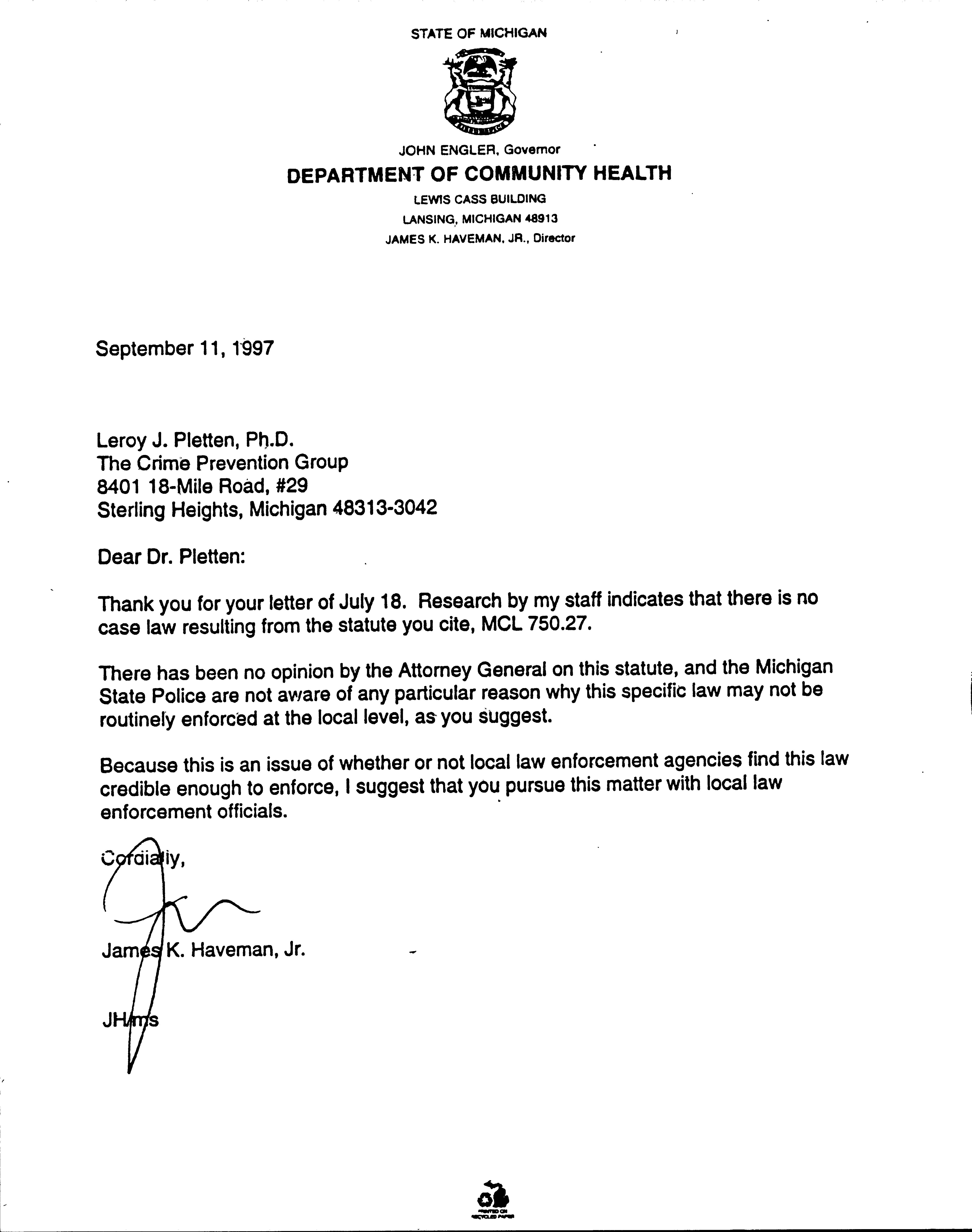|
State of Michigan

John Engler, Governor
Department of Community Health
Lewis Cass Building
Lansing, Michigan 48313
James K. Haveman, Jr., Director
|
September 11, 1997
Leroy J. Pletten, Ph.D.
The Crime Prevention Group
8401 18 Mile Road #29
Sterling Heights, Michigan 48313-3042
Dear Dr. Pletten:
 Thank you for your letter of July 18. Research by my staff indicates that there is no case law resulting from the statute you cite, MCL 750.27. Thank you for your letter of July 18. Research by my staff indicates that there is no case law resulting from the statute you cite, MCL 750.27.
There has been no opinion by the Attorney General on this statute, and the Michigan State Police are not aware of any particular reason why this specific law may not be routinely enforced at the local level, as you suggest.
Because this is an issue of whether or not local law enforcement agencies find this law credible enough to enforce, I suggest that you pursue this matter with local law enforcement officials. [See local hostility example].
Cordially,
/s/James K. Haveman, Jr.
James K. Haveman, Jr.
JH/ms
|
|
Emphasis was added above in red.
This law was passed to make Michigan smoke-free everywhere, pursuant to the wisdom of that era deeming it more efficient to criminalize only at the manufacture, sale, and give-away level, those few, vs. criminalizing millions for useage.
To see data on cigarettes' notoriously deleterious ingredients, click here.
To see the Director's preceding 9 July 1997 letter, click here.
To see then Governor Engler's preceding 22 August 1997 finding of a cigarette smuggling emergency, click here.
To see his 11 Jan 1999 message overview of the cigarette hazard to Michigan, click here.
To see the DCH's 17 April 2003 letter on second-hand smoke, click here.
For analysis of the 1909 Michigan law—with examples of cigarettes' deleterious ingredients, emissions, and adulterants, and resultant adverse effects, click here.
The above includes a bibliography of pre-1909 writings and court precedents identifying deleterious effects of tobacco, by 1909 already LONG KNOWN in the medical profession, and of which, judicial notice had already long been taken.
For pertinent legal terms and their definitions, click here.
See also Michigan's advertising ban law.
 
Note that due to Michigan's distinctive shape and borders, enforcement is easier than perhaps for other states. Michigan is bordered by large bodies of water on the East and West, and by Canada [with customs inspection] on the North amd East.
Only on the South side, are cigarettes typically widely smuggled [imported] into our jurisdiction.
Enforcement can be as simple as notifying the State Police to interdict and confiscate the arriving cigarette shipments. They are commonly along I-75 on the south border of Michigan.
This law can also be enforced in conjunction with the ban against under-age sales. List that selling as "Count 1," and the violation of this law as "Count 2."
Why does this law exist? Here is an answer:
1. The cigarette hazard and many cigarette effects (though not all) were already then known.
2. The adulteration by coumarin issue had already been published.
3. The common law "right to fresh and pure air" already existed (since at least the year 1306).
4. A number of Michiganders saw that due to rampant violations of that right by smokers, it needed to be institutionalized.
5. That era still had the Blackstonian-common-law concept that government can neither violate rights, nor allow others to do so.
In that era, medical science, emphasizing prevention, was conquering smallpox, plague, yellow fever, etc. Confidence was high that life-style diseases (e.g., those from tobacco) could soon be the next eliminated.
 
Michiganders were devout and educated. They wanted to prevent the known cigarette effects. They knew about prevention (smallpox vaccinations, hygiene, proper diet-rest-exercise, fresh air, etc.) as a routine part of life.
In short, many 19th century activists wanted what is now called a "comprehensive integrated program." This means that adults must set a proper moral behavioral example for children. This emphasis is not 'do as I say, not as I do'! It is not just 'encouraging'! They said 'No' to pusher power to overwhelm.
Significantly, far more so than now, that era activism was concerned about national and adults' example,- for setting a good one,
- against setting a bad one:
See that era's writings (1833-1916):
(In law, people including adults cannot consent
to acts causing them great bodily harm;
but adults' merely appearing to do so
[though without legal validity]
itself sets a bad example.)
 
Michiganders therefore [whether pursuant to some or all examples guidance] correctly identified that banning manufacture, and banning sales to adults, was crucial: crucial to preventing ADULTS' bad example of using cigarettes.
So Michigan banned deleterious cigarette manufacture and selling.
Note the emphasis. To deter and prevent sales, they saw the need not just to act against retailers, but also to ban manufacture. This was indeed comprehensive.
The enlightened 1909 and 19th century approach was to NOT argue people--children being targeted before age 18, i.e., before legal age to even make a contract, much less a life-time decision--into not starting smoking. That 19th century approach was also to NOT argue with adults (addicts) to get them to stop. The enlightened 19th century approach was also to NOT criminalize the millions, but to focus on manufacturers and sellers, a narrower and thus more enforceable approach.
When the nation banned slavery, for example, lawmakers did NOT target the slaves!! just slaveholders! They followed the same enlightened approach on chemical slavery including tobacco. "Moral" aspects of tobacco, were already then being reported, e.g., increased rates of
alcoholism, medicolegal.tripod.com/preventalcoholism.htm
baby deaths aka abortion, medicolegal.tripod.com/preventabortion.htm
divorce, medicolegal.tripod.com/preventdivorce.htm
crime, medicolegal.tripod.com/preventcrimes.htm. |
Professor Arthur Holmes (of Pennsylvania State College), in "The Psychology of Smoking" said, "If men did not smoke, boys would not. All the appeals and all the legislation possible, therefore, which would suppress the open and overt uses of tobacco are good."
In the book, The Use and Abuse of Tobacco, by Surgeon John Lizars, M.D. (Edinburgh, Scotland: 1859), a full ban on tobacco had been recommended, based on the hazard already being known, and following a Swiss precedent of banning sales to youths only, see page 49. Dr. Lizars said the hazard is comprehensive, not just to youth ("the health of the community is injured by the use of tobacco"), protect everybody.
Dr. Lizars also said that in 1857, the medical journal The Lancet had provided guidance on "excess smoking" in context of a 10-year programme for youth avoidance of tobacco, that if followed, would have led to abolition of smoking by 1867. As Michiganders of 1909 knew, that "youth" focus had not worked. Focusing on youth does not, and cannot work, as long as the product remains available. Wherefore they (1909 Michiganders) concluded to ban the manufacture and sale. (See later writings against mere "youth focus.")
In the same era, Rev. Benjamin Lane, in The Mysteries of Tobacco (New York: Wiley and Putnam, 1845), pp 50-51, had proposed an immediate tobacco ban with "severe penalties."
Cigarettes cause "the worst of all drug habits, the smoking of tobacco"—Herbert H. Tidswell, M.D., The Tobacco Habit: Its History and Pathology (London: J. & A. Churchill, 1912), p 69. Banning the "worst" drug, tobacco, in this 1897 'controlled substances act,' = banning them all! as per the medical fact that eliminating the cause = eliminating the effects; here, eliminating the gateway drug = eliminating the post-gateway drugs.
Protecting children only, without banning sales to adults, long has been found to be ineffective, say Luther H. Higley, et al., The Evils of Tobacco and Cigarettes (Butler, Indiana: The Higley Printing Co, 1916), p 60; and H. S. Gray, "The Boy and the Cigarette Habit," 29 Education 294-315 at p 311 (1909).
Michiganders of that era were educated,
- not misinformed or intimidated by the tobacco taboo,
- not afraid to adopt the consumer protection concept, "products must be safe for intended use,"
- not allowing the tobacco lobby to dictate their response.
So they passed a comprehensive integrated effects prevention law, preventing all cigarette effects, known then or not. In essence, this law institutionalizes the right to life and due process, as per the common law
For additional background and context on the law, see, e.g.,
Michigan Digest, "Criminal Law and Procedure," § 128
Michigan Digest, "Former Jeopardy," § 7.10
Michigan Law and Practice, Vol. 33, "Unfair Competition and Consumer Protection," § 62 (2004).
Nebraska later followed Michigan's example, and passed a law, No. 28-1421 (1919), saying inter alia, "Only cigarettes and cigarette material containing pure white paper and pure tobacco shall be licensed" (full text in Nebraska Revised Statutes, Vol 2A, p 299, 1995 Reissue).
  "Public health is the foundation on which reposes the happiness of the people and the power of a country. The care of the public health is the first duty of a statesman."—Benjamin Disraeli (1804-1881). "Public health is the foundation on which reposes the happiness of the people and the power of a country. The care of the public health is the first duty of a statesman."—Benjamin Disraeli (1804-1881). |
The states of Iowa and Tennessee had been cigarette-ban leaders in 1897.
"The facts about smoking and mental illness are stark. Almost half of all cigarettes sold in the United States (44 percent) are consumed by people with mental illness. This is because so many people who have mental illnesses smoke (50 to 80 percent, compared with less than 20 percent of the general population) and because they smoke so many cigarettes a day -- often three packs. Furthermore, smokers with mental illness are much more likely to smoke their cigarettes right down to the filters." Source: Steven A. Schroeder, "A Hidden Epidemic," (Washington Post, 18 November 2007), p B07. Laws such as these are designed to prevent and preclude this situation.
In the precedent of State of Kansas ex rel Johnston, State Attorney General v Foster, County Prosecutor, 3 P 534 (Kansas, 2 April 1884), there was a removal of a prosecutor for refusing to enforce the Prohibition law. On appeal, the Court said that prosecutors must enforce the law regardless of personal desires and clamor of the law's opponents, for reasons including that those of the citizenry who are for the law count on them doing so; 'mistake of law' is not a defense.
The fired prosecutor appealed to the U.S. Supreme Court, in Foster v Kansas ex rel. Johnston, 112 US 201; 5 S Ct 8; 28 L Ed 629 (27 Oct 1884), and Foster v State of Kansas ex rel. Johnston, 112 US 205; 5 S Ct 97; 28 L Ed 696, 697 (10 Nov 1884). The U.S. Supreme Court upheld the removal of the prosecutor.
Luteran v U.S., 93 F2d 295 (CA 8, 1937), provides insight re non-enforcement.
It says, "where proof of a conspiracy has been established a relatively slight amount of evidence connecting the defendant therewith is sufficient to sustain a verdict," p 398.
"Participation in formation of the conspiracy is not essential to culpability if after it was formed the defendant aided or abetted it with an understanding of its purpose," and "where the defendant aided the conpsirators knowing in a general way their purpose to break the law the jury may infer that he entered into an express or implied agreement with them," p 399.
This includes evidence of some participation including having "heard and saw various other things which characterized the fraudulent [unlawful] conduct of the conspirators," p 399.
"Every hypothesis of innocence is destroyed by his knowledge of the manner in which . . . conspirators had behaved throughout the afternoon," p 399.
In this case, the pattern of law-breaking is not one "afternoon," but decades.
Such long term conduct refusing to enforce the law, deprives the employer, of "honest services." Federal laws, e.g., 18 USC §§ 1341, 1343, and 1346, make fraud defrauding employer of "honest services" illegal.
The term “‘honest services’ can include ‘honest and impartial government.’”--U.S. v Brumley, 116 F3d 728, 731 (CA 5, 1997) cert den 522 US 1028; 118 S Ct 625; 139 L Ed 2d 606.
“A defendant may be prosecuted for deprivation of honest services [even] if he [the offender, e.g., prosecutor never enforcing the cigarette law] has [not a single illegal intent but] a dual intent, i.e., if he is found to have intended both a lawful [as they may allege] and an unlawful purpose to some degree.”--U.S. v Woodward, 149 F3d 46, 71 (CA 1, 1998), cert den 525 US 1138; 119 S Ct 1026; 143 L Ed 2d 37.
The Dept of Justice is currently prosecuting an "honest services" case, U.S. v James J. Smith.
For an example of how this concept was applied in a Macomb County case, though another context, as these precedents have general application, click here.
|

This site is sponsored in the public interest by
The Crime Prevention Group
|





